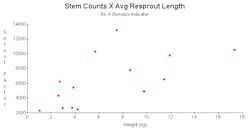The Validity of an Estimation of Biomass
Herbicide efficacy for brush control has generally been determined by assessing treated stems for stem kill. The stem kill is measured by determining the condition of the cambium layer. The bark is stripped back on treated stems and a rating number is assigned (ie. 0-100%) based on how far down from the apex the cambium has been rendered non-viable. This method is reasonable for many herbicides which are most active in meristematic tissue and where the brush species under study does not have a strong proclivity to reproduce vegetatively.
When the tree species under study readily reproduces vegetatively stem kill of the treated stems is an incomplete and inadequate measure of control. The measurement of stem kill does not yield information relevant to the persistence of the control. It is, in fact, the persistence of the control which is of material interest to the vegetation manager. For the pipeline or power line manager it is the amount and speed of regrowth of the targeted species which determines the maintenance cycle. For the forest manager the amount and speed of regrowth determines the window of opportunity available to the crop trees. What these vegetation managers require is not so much an assessment of kill but an assessment of the duration of control. This requires examining to what degree the target species exist and are proliferating.
A measure of the biomass of the targeted species would constitute significant information for the vegetation manager. In agricultural research this number is usually determined by harvesting the competing weeds, oven drying them and recording dry weights. Although, this approach would work for brush control the logistics of removing woody plants and transporting them from often remote areas to a laboratory becomes inhibiting. It would be desirable to have a measure of biomass which does not require the removal, transportation and further handling of the regrowth.
It was established that a count of the viable stems of a target species and the maximum or average sprout height were data easily gathered in the field. To determine if these data could be used as a reasonable estimate of biomass a trial was undertaken. Twenty 4 square metre plots were randomly selected. For each plot all the viable poplar species stems were counted and the average height recorded. These two values were multiplied and labeled the Sprout Factor. All the viable poplar stems were removed from each plot and weighed to establish the actual biomass.
The biomass and the Sprout Factor were tested for correlation. This test yielded an r value of 0.87. Given that such a strong correlation exists it may be concluded that the number of sprouts multiplied by the sprout length is a reasonably good estimate of the biomass.
Herbicide efficacy ratings based on stem kill and a biomass indicator, such as the sprout factor, will yield information more pertinent to future vegetation management requirements. In addition one of the data used for the derivation of the sprout factor, sprout height, yields information about expected maintenance cycles.
(TransAlta Utilities Corporation, Sherwood Park, Alberta).

